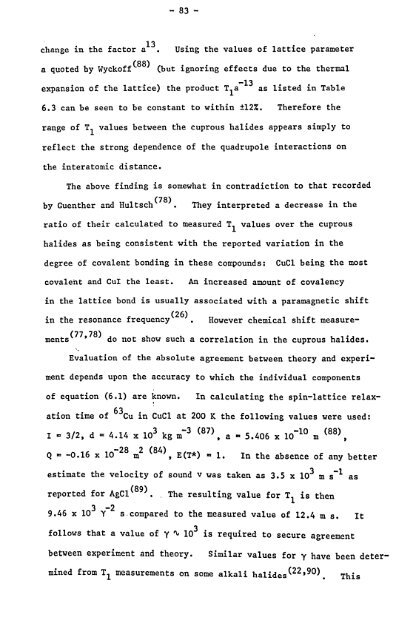NNR IN RAPIDLY ROTATED METALS By - Nottingham eTheses ...
NNR IN RAPIDLY ROTATED METALS By - Nottingham eTheses ...
NNR IN RAPIDLY ROTATED METALS By - Nottingham eTheses ...
Create successful ePaper yourself
Turn your PDF publications into a flip-book with our unique Google optimized e-Paper software.
- 83 -<br />
change in the factor a13. Using the values of lattice parameter<br />
a quoted by Wyckoff<br />
(88)<br />
(but ignoring effects due to the thermal<br />
expansion of the lattice) the product T1a^13 as listed in Table<br />
6.3 can be seen to be constant to within ±12%. Therefore the<br />
range of T1 values between the cuprous halides appears simply to<br />
reflect the strong dependence of the quadrupole interactions on<br />
the interatomic distance.<br />
The above finding is somewhat in contradiction to that recorded<br />
by Guenther and Hultsch(78). They interpreted a decrease in the<br />
ratio of their calculated to measured T1 values over the cuprous<br />
halides as being consistent with the reported variation in the<br />
degree of covalent bonding in these compounds: CuC1 being the most<br />
covalent and CuI the least. An increased amount of covalency<br />
in the lattice bond is usually associated with a paramagnetic shift<br />
(26)<br />
in the resonance frequency. However chemical shift measure-<br />
ments(»'78) do not show such a correlation in the cuprous halides.<br />
Evaluation of the absolute agreement between theory and experi-<br />
ment depends upon the accuracy to which the individual components<br />
of equation (6.1) are known. In calculating the spin-lattice relax-<br />
ation time of 63Cu in CuCl at 200 K the following values were used:<br />
3 -3 (87) (88)<br />
Ia 3/2, d=4.14 x 10 kg ma5.406 x 10-10 m<br />
Q- -0.16 x 10-28 m2 (84), E(T*) - 1. In the absence of any better<br />
estimate the velocity of sound v was taken as 3.5 x 103 m s-1 as<br />
reported for AgCl(89).<br />
. The resulting value for T1 is then<br />
9.46 x 103 Y2s. compared to the measured value of 12.4 m s. It<br />
follows that a value of Y ti 103 is required to secure agreement<br />
between experiment and theory. Similar values for y have been deter-<br />
mined from T1 measurements on some alkali halides(22'90). This

















